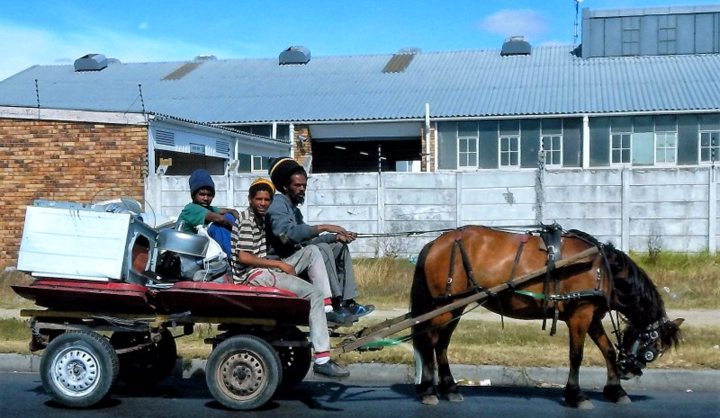South Africa
GroundUp: Putting the horse before the cart

Cart horses depend for their welfare on their drivers and owners, and the grooms and farriers that help them. Text and all photos by Nicholas Ashby for GROUNDUP.
First published by GroundUp
Every day in Cape Town’s industrial areas, horses that haul carts of scrap-metal and wood face traffic hazards and even bullets from gang fights. Their existences are tied to the character and fate of their owner or driver.
The “carties”, as they are known, work in the tradition of their fathers and grandfathers, and depend heavily on the horses for their livelihood – and the horses in turn depend on their owners and drivers for their welfare. In this, they are assisted by the Cart Horse Protection Association (CHPA), but the relationship is not without its tensions.
Jonah’s new stables
Jonah (not his real name) lives in Delft and depends on three working horses and two foals.
“His horses are always in reasonable condition,” Diana Truter, a cart horse inspector, says en route through the sandy roads near Cape Town International Airport where Jonah has his home.

Pigs up to their elbows in fecal mud in a backyard in Delft.
The CHPA has offered to rebuild Jonah’s stable. He lives with his family in a compact yard with some friendly dogs and some pigs that snort, snuffle and squelch muddily behind barricades. The condemned stable exudes a hard-hitting stench from within its dankness. Rank seepage oozes from a small next-door pig sty, slightly raised from the stables, where young pigs stand elbow-deep in fecal mud.
Jonah smiles and rolls his shoulders in wriggling pantomime. “They like the wet.” But he admits the pigs need a dry place to sleep.
The CHPA’s team prepares to take down the old stable. It is soon clear that Jonah is somewhat peeved; he hadn’t expected the CHPA to re-use his stable’s existing zinc roof.
Jonah’s horses are grazing beyond strung-together rusty mattress skeletons which, along with planks and barbed wire, form fences separating yards and gardens. He points at his white horse’s elbows; blood weeps from cuts, torn open by a dog that bolted into the street last week.

A cart horse that was attacked by a dog.
On a stall-divider there hangs a gaudy old picture of Christ, so faded he’s barely visible. He floats in blessing over a sturdy red-roofed farmhouse, in stark contrast to the ramshackle compound, where humans share off-plot communal plastic toilets, as well as water taps with neighbours who generally live on neater plots. Another key infrastructural lack in this yard is formal drainage.
Jonah says he has lived here for 15 years, raising pigs, which he sells “now and then”, though he doesn’t eat them, for religious reasons. He says there are government plans to develop the area. He’ll find another place for his pigs, and go back to nearby Crossroads where he was born and grew up. His father and grandfather had horses. He loves horses, he says.
“I care because I get bread from the horses. If I don’t have horses, how can I live? Otherwise, I must go to steal … I don’t want to go to jail.”
He says sometimes when people see him and his horse cart, they shoo him away. He blames it on other cart horse scrap movers who he says housebreak and steal gearboxes. Carties have a bad reputation in certain quarters.
By the end of the day, new stables, lighter and airier, have been erected by the CHPA on higher ground away from the filthy pig sty.

Carties and their horses face many dangers on the roads.
Jonah’s little girl has spent the day playing on the site. Her older brother has fed the pigs and chopped wood. At one stage, the boy argued rudely with his stepmother, Jonah’s wife, about his truancy. They even threatened each other with broken bricks. Now, the boy and the young wife, who Jonah says was addicted to drugs, cheerfully wave goodbye to the CHPA team and carry on rinsing their slop buckets from a dripping tap.
A week later, plans are made to return to offer sterilisation and inoculation. If they need to lend a hand fixing up the pigs’ quarters they will.
Sadly, they find the newly erected stables in a filthy state. They alert the NSPCA which will visit and issue a warning to Jonah about the condition of the pigs. The boy has gone missing too. The family think he is now living on the streets.
Well-being of humans and their animals
In its 21 years, the CHPA has grown into a highly effective non-profit organisation. It oversees not just the well-being of around 2,000 working-horses and donkeys, but also the community of owners and drivers.
The CHPA plans to expand. There are practical reasons for creating an outreach and youth development programme, particularly when serving struggling communities. There are also wider social issues. Animal protection investigators are aware that the needs of farm animals and children living in close proximity to each other other, as well as pets, often intersect.

Bonghi Mangali, a farrier for the CHPA.
Each weekday, a procession of carties trundle into the CHPA’s Epping base, where the condition of each animal is checked. The horses are dewormed. Their hooves are cleaned, filed and balanced by the CPHA’s farriers, and then re-shod. Owners and carties are resupplied feed at a discount. The CPHA goes through nearly 5,000 bales of oat hay a month for feed.
The CHPA’s veterinary service visits backyard stables around the Cape Flats, and deworms and vaccinates against tetanus. Last year, it logged a total of 480 visits to various yards.
Administrator Penny Lankester says the CHPA has three inspectors for Cape Town. Compare that to the local NSPCA which has 12 inspectors for the entire Western Cape for not only domestic animals and pets but wild and farm animals too.
‘We are living in poverty’
GroundUp accompanied Truter and her team to return a horse to an owner living on Freedom Farm located on Cape Town airport land. It is home to several hundred families and under threat from a plan to build a new runway.
Some, including horse owners, have already moved to the N2 Gateway housing project. With little open grazing there, and hazardously close to the multilane highway, the CHPA has had to step up by supplementing feed.
Overhead, planes disappear into drizzly clouds as the CHPA team treats horses in a yard. A neighbouring cart horse owner, Joseph Diedrick, comes by.
Diederick is not a big fan of the CHPA. “We are living in poverty,” he says, “and poverty causes crime. To prevent crime, you buy a horse, and seek metal and scrap to earn a survival, so you don’t go to jail for doing other things. But now they [the CHPA] take your piece of bread away.”
He points to a horse he recently bought, which turned out to be lame.
Diedrick says, “I sent the CHPA an e-mail to tell them about their dirty work. We are poor people. We suffer. Most of the time we don’t have something to eat, because you must take all that you have and put it there.” He points to the stable. “After all that effort, your time, your money, they come and say this horse is cripple.”
A model stable
Meanwhile, in the modest suburbs of the Cape Flats, owners confine horses in unlikely stables, cramped up hidden side-alleys.
Jeremy Abrahams’ stable is spacious and smells of far sweeter stuff than old manure. A measure of its cleanliness is that Ricardo Claasen, a groom, lives in an adjoining room. On a beam is painted: IN THIS STABLE IT’S ALL ABOUT HORSES!!! WE EAT, DRINK, WE SLEEP, WE CARE FOR HORSES!!!
“Remember,” says Abrahams, “the horse doesn’t want you. It’s you who wants the horse.”
Truter says she wishes all the stables were like Abrahams’s.
A cart horse’s working life rarely lasts beyond 20 years. Horses’ knees don’t fully develop until they are three. Rush a young horse onto the streets before then, or overwork it, and an owner won’t get much beyond eight or nine years road time plod out of a horse.

Ricardo Claasen and his cart horse let rip.
Once, while conducting a regular cart horse registration and compliance road block, Truter was called by a member of the public. A pony had collapsed and a mare had to pull both loads to Sir Lowry’s Pass Village about 40km from the city. The pony and mare were confiscated when the horses’ drivers refused to engage with Truter. They only agreed to release the horses into her care once Rhyno Meyer, a groom at the CHPA’s recovery and rehabilitation sanctuary, arrived on the scene.
When the mare was brought in, her back was finished, according to manager Vicki Strydom. “It was in fixed spasm. You touched it even lightly and she’d tremble in pain.”
Strydom, a former equestrian unit officer, thinks cart horsing is by definition a form of abuse – hunger, gunshots going off, kids throwing stones, being tied up in dirty stables.
Where Boxer goes…
The sanctuary where rescued animals are kept is on a smallholding in the shadow of the Hottentots-Holland mountains.
Meyer points to a rescued horse. The vet took a bullet out of her. When she came in, he says, you could see white bone.

Ashley Deelman – harness-maker, farrier, and key member of the CHPA’s outreach and youth development programme.
Meyer used to be a cartie. He rented horses and carts from the father of the CHPA’s head farrier and youth development pioneer, Ashley Deelman.
“Every day, you’re supposed to bring in R200 for the owner and buy food for the horse. The rest of the money and the scrap is yours. Later, you give the owner some money from the scrap you sold, half-half maybe, and sort the horse out paying for shoes and food,” says Meyer.
Megan White of the CHPA’s outreach and youth development project says September 2015 was really bad. Five horses were involved in road accidents; one had to be euthanised at the scene. Cart horses are especially vulnerable on highways.

Rhyno Meyer, a groom at the rehabilitation centre, with a retired cart horse.
Newly retired cart horses go through three months’ training to acclimatise them to whatever their new lives will be. In the past year, 36 horses were taken into the sanctuary; 14 willingly signed over by owners, 10 confiscated in accordance with the Animals Protection Act, six for medical treatment, four came back from adopted homes, one for rehabilitation, and a foal was born. At the same time, 15 horses went out to “forever homes”.
Strydom profiles each horse for the adoption programme. Although some animals coming out of the carting industry will never be temperamentally suited to be ridden, some are adopted by riding schools. Some are taken as companions to farm horses. Other will see out their days in the care of the association. DM
Main photo: Shaun Isaacs driving his cart horse Clara. Photo by Nicholas Ashby.

















 Become an Insider
Become an Insider